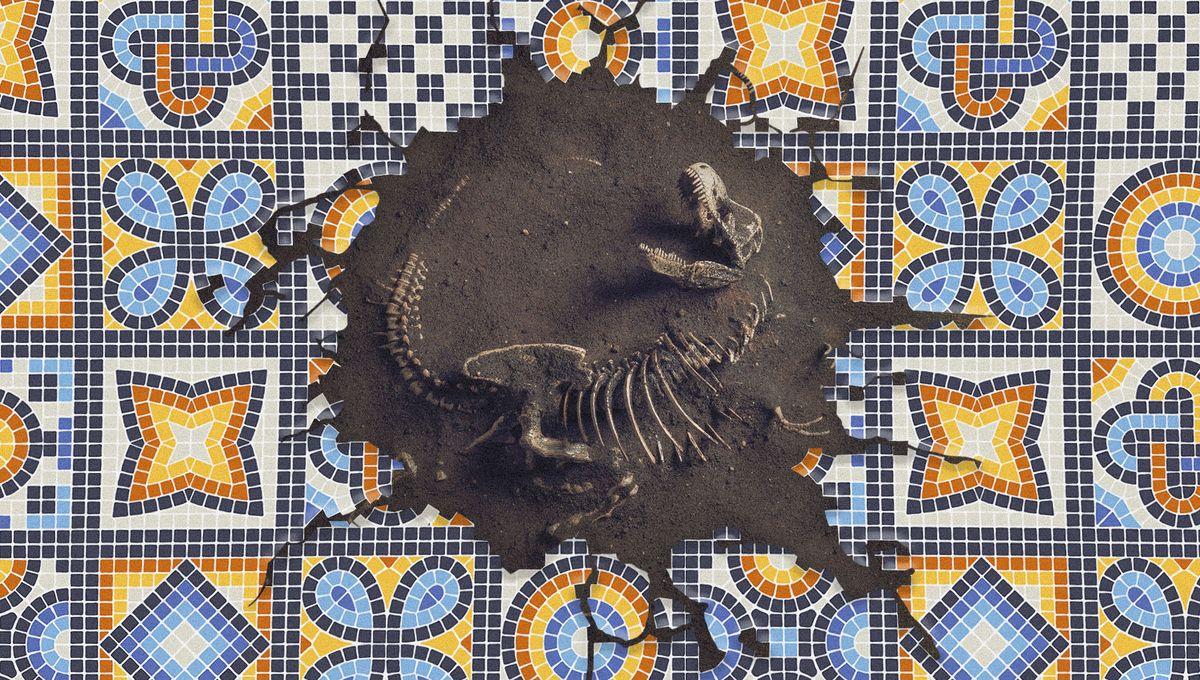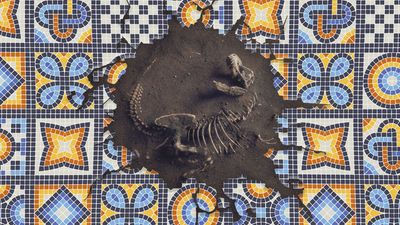If you’ve ever seen a mammoth skull, you’ll have noticed the gaping nasal cavity that sits front and center, like a giant, singular eye socket. Without knowing what the animal looked like when it was alive, you’d swear that the thing was an enormous one-eyed monster, so it’s hardly surprising that these fossilized pachyderm remains were once interpreted as cyclops skeletons.
The rest of this article is behind a paywall. Please sign in or subscribe to access the full content. First appearing in Homer’s Odyssey, these man-eating beasts are far from the only mythological creatures that may have been inspired by fossils. At the same time, prehistoric finds that lacked a more obvious explanation were sometimes used to validate pre-existing myths and fables, with enormous bones being misidentified as members of the pantheon from which mortal beings descended. While the ancient Greeks and Romans may have had a gift for inventing mythological characters, our fascination with fossils precedes these classical legends by many millennia. There’s even evidence to suggest that Neanderthals may have taken an interest in these primordial relics, with a collection of 15 marine fossils found in a cave in Spain that was once inhabited by our extinct sister lineage. And while it’s unclear exactly what Neanderthals may have wanted with a bunch of old mollusk casts, researchers suspect that the specimens may have been gathered by the clan’s children, who simply liked the way the fossils looked and decided to hoard them, much like modern youngsters who collect stickers or stamps. Moving on to our own species but staying firmly in the realm of prehistory, a trilobite fossil discovered at a Middle Stone Age site in South Africa provides further evidence of fossil collection by archaic Homo sapiens. Dated to around 65,000 years ago, the extinct marine arthropod is thought to have been used for either ritual or ornamental purposes, although researchers can’t say with any certainty what these might have been. This penchant for fossil collecting then reached new heights in the Bronze Age, when the tomb of a young woman in Bedfordshire, England, was filled with hundreds of fossilized echinoids – or sea urchins. Once again, it’s unclear why these spiky remains were placed in the grave, but their use as funerary offerings suggests a ritual or supernatural function. All of which brings us to the Romans, who also appear to have taken an interest in prehistoric remains. Though examples are scarce, researchers did recently find a trilobite fossil at a site in northern Spain, which was probably once used as a magical amulet that was worn for protection. According to the Roman historian Suetonius, Emperor Augustus was fascinated by the bones of extinct animals, and even started a collection which ultimately became the world’s first palaeontological museum. Supposedly, Augustus interpreted these fossils as the remains of giants and monsters from a bygone era, although the extent to which this idea was colored by mythology as opposed to science remains unknown. While classical folklore likely imbued fossils with supernatural powers or misidentified them as mythological beings, many of the leading Greek and Roman scholars took a more scientific stance on these finds. Way back in the sixth century BCE, for instance, the Greek philosopher Xenophanes correctly interpreted fossilized fish and sea shells on the island of Malta as evidence for a prehistoric ocean. Similarly, Herodotus pointed to marine fossils in Egypt as proof that the country was once underwater. They understood 'extinction' because they knew that the creatures whose bones they found no longer existed but vanished in some catastrophe in the deep past. Adrienne Mayor “There is plentiful evidence that the ancient Greeks and Romans recognized the biological nature of not only small invertebrate fossils such as shells, but they understood that the enormous fossil bones of extinct mammals had belonged to immense creatures that flourished in the deep past and then disappeared en masse,” says historian Adrienne Mayor from Stanford University. The author of the influential book The First Fossil Hunters, Mayor is a leading researcher when it comes to Greek and Roman takes on fossilized remains. “They perceived that the fossils were extremely old, from the remote past when mountains and seas were being formed, before the current human era,” she told IFLScience. “They understood 'extinction' because they knew that the creatures whose bones they found no longer existed but vanished in some catastrophe in the deep past.” However, while Mayor says that the attempts of classical scholars to find natural explanations for the existence of fossils may represent “the first inklings of the scientific impulse,” fantastical interpretations that invoked myth and legend were also rife in the ancient world. Greek and Roman mythology is populated by demigods like Hercules, who were believed to have been human-like in proportion but heroic in size. Conditioned by these mythic tales, ancient fossil finders were quick to associate the bones of massive prehistoric creatures with their mythological champions. Pliny the Elder, for instance, once wrote about a skeleton measuring 46 cubits in length, which was found on the island of Crete and was assumed to have been the body of either Orion or Oto, the son of Poseidon. The Greek geographer Pausanias, meanwhile, described the discovery of a kneecap the size of a discus, which was said to belong to Ajax, a hero of the Trojan War. The belief that the human era was preceded by an age of giants persisted for a surprisingly long time, and it wasn’t until the 18th century when a naturalist from Northern Ireland called Sir Hans Sloane finally debunked the idea by demonstrating that all of the skeletons attributed to these colossal beings were in fact the fossils of whales, elephants and other enormous mammals from the Cenozoic period. In the seventh century BCE, the Greek poet Aristeas introduced the world to one of the most terrifying and enduring monster myths of the ancient world – that of the Griffin. Except, as far as anyone thought at the time, there was nothing mythical about these fearsome creatures with the body of a lion and the wings and head of an eagle. Rather, Griffins were considered real-life animals that guarded the gold deposits of central Asia from greedy human prospectors. Aristeas learned of these horrifying creatures from Scythian nomads who told him about a vast desert littered with gold and fiercely defended by Griffins. Within a short space of time, the beasts began appearing in classical artworks as belief in the story spread through the Greek world. “Many other classical Greek and Roman writers added details to the Scythian legend, such as Griffin eggs in nests on the ground along the routes to gold deposits,” says Mayor. “From Herodotus to the natural historian Aelian, roughly 1,000 years later, the Griffin of the eastern deserts was thought to be a real animal, but no one ever claimed to see a live Griffin.” In her book, Mayor argues that the entire notion of the Griffin was in fact based on a genus of small dinosaurs called Protoceratops, which lived in central Asia during the Late Cretaceous period. Like Griffins, these 70-million-year-old creatures stood on four legs and sported both beaks and what looked like wings (but were actually frill-like extensions on their skulls). According to Mayor, Protoceratops fossils are commonly spotted along these ancient gold trading routes, and could therefore have inspired the original Scythian Griffin story, which later took hold in Greece and other ancient realms. However, not everyone agrees, with some questioning whether gold prospectors in Asia would really have noticed these old Protoceratops bones. “If they wanted to see more, as they’d need to if they were forming myths about these animals, they’d have to extract the fossil from the surrounding rock. That is no small task, even with modern tools, glues, protective wrapping, and preparatory techniques," palaeontologist Dr Mark Witton, author of a paper on the very subject, told IFLScience last year. "It seems more probable that Protoceratops remains, by and large, went unnoticed – if the gold prospectors were even there to see them.” “Fossils may have played a role in how ancient Greeks and Romans pictured Griffins,” says Mayor. “But we can’t know whether fossils were actually the source of the tale.” “This scenario is plausible but cannot be proven or disproven,” she concludes. The same can be said of the cyclops myth. According to most readings of the Odyssey, it was on the island of Sicily that Odysseus and his men encountered the one-eyed man-eating giant Polyphemus. Interestingly, this same island was once home to a now-extinct species of dwarf elephant, which left behind skulls that appeared to display a huge, central orbit. Elsewhere in the Mediterranean, the island of Crete has yielded the remains of massive proboscideans called Deinotherium giganteum, which possessed similarly cyclops-like skulls. The fact that these fossils are often found alongside the remains of other, smaller animals may therefore have been interpreted by ancient fossil finders as the bones of humans who had been devoured by the voracious monster. “Again, we cannot say whether discoveries of fossil mammoth or other prehistoric elephant skulls inspired the myth of a one-eyed ogre called the Cyclops,” says Mayor. “All we can say is that when people who did not know about living elephants, like the Greeks in the time of Homer, came across a mammoth skull, it would be plausible for them to think that the central hole was an eye socket and perhaps visualize a one-eyed giant.” In the end, then, it’s impossible to discern whether fossil discoveries inspired the creation of ancient myths, or were simply interpreted in ways that validated existing legends. It’s also worth pointing out that a huge number of these ancient tales have no relation to fossils whatsoever. At the same time, though, Mayor says that “if stories about giants and colossal monsters were common knowledge and then people happened to come across some immense or strange bones, they would naturally turn to the old myths to try to explain the fossils.”The First Bone Collectors
The Rise Of Palaeontology
The Age Of Giants
Monster Discoveries




